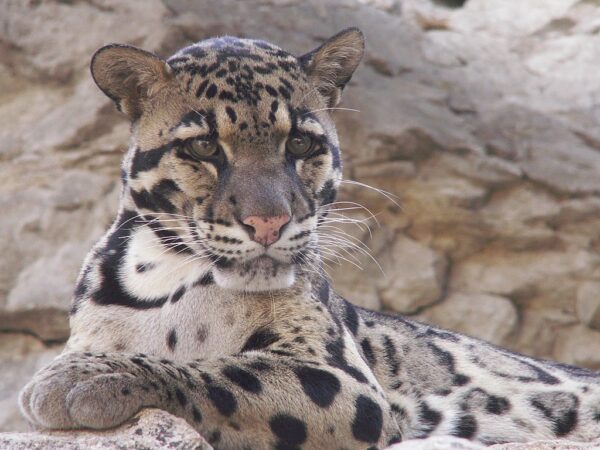The clouded leopard (Neofelis nebulosa) is a wild cat inhabiting dense forests from the foothills of the Himalayas through mainland Southeast Asia into China. It is also called the mainland clouded leopard, as opposed to the Sunda Island clouded leopard (Neofelis diardi). The clouded leopard is characterized by large, irregularly-shaped dark spots on a pale background, and large size compared to other cats found in its range. It is the largest member of the cat family Felidae in the Indo-Malayan region, although it is typically smaller than the big cats of Africa and North America.
Habitat and Range
Clouded leopards are found throughout the Himalayan foothills, including Bhutan, Nepal, India, Laos, Myanmar, Thailand, Vietnam and southern China. They inhabit tropical evergreen and deciduous forests up to an altitude of 4500 m. In Nepal, they have been recorded in royal chital deer habitats above 1500 m. In northern India and southern China, they occur in hilly regions up to 3000 m above sea level. In Bhutan, they have been recorded up to an altitude of 3600 m.
Diet
The diet of a clouded leopard consists mainly of small and medium-sized mammals weighing 1–15 kg (2.2–33 lb). In the Himalayan foothills region of India, their primary prey items are barking deer and hog deer. Other prey items include serow, takin, pika, porcupine and hare. In Nepal’s Chitwan National Park, their primary prey items were rhesus macaques and Hanuman langurs. In Thailand’s Khao Yai National Park their primary prey were pig-tailed macaques. Smaller prey items include birds, rodents and reptiles. Occasionally they will take larger prey such as sambar deer weighing up to 80 kg (180 lb), though this appears to be more common among males than females.
Social Habits
Clouded leopards are generally solitary animals except for mothers with cubs and during mating season. They mark their territories with urine scent marks and scratch marks on trees. Males have larger home ranges than females which overlap with those of several females but not with other males. Females tend to be more sedentary than males with home ranges that vary between 2 and 12 km2 (0.77–4.59 sq mi). Male home ranges vary between 7 and 20 km2 (2.7–7.7 sq mi).
Sources
- https://en.wikipedia.org/wiki/Clouded_leopard
- https://nationalzoo.si.edu/animals/clouded-leopard
- https://www.britannica

